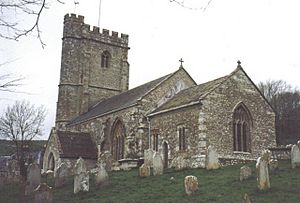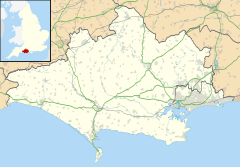Litton Cheney facts for kids
Quick facts for kids Litton Cheney |
|
|---|---|
 Parish church of St Mary |
|
| Population | 359 |
| OS grid reference | SY552907 |
| Unitary authority |
|
| Shire county | |
| Region | |
| Country | England |
| Sovereign state | United Kingdom |
| Post town | Dorchester |
| Postcode district | DT2 |
| Police | Dorset |
| Fire | Dorset |
| Ambulance | South Western |
| EU Parliament | South West England |
| UK Parliament |
|
| Website | Village website |
Litton Cheney is a charming village and civil parish (a local government area) in the county of Dorset, located in south-west England. It's about 9 kilometers (6 miles) west of Dorchester, which is the main town in Dorset. The village sits peacefully below chalk hills in a small valley, with the River Bride flowing nearby. In 2011, about 359 people lived in Litton Cheney.
A Glimpse into the Past
Long ago, on a place called Pins Knoll, west of the village, there was an Iron Age settlement. This was a community from a time when people used iron tools, around 800 BC to AD 43. Archaeologists dug here in 1959 and found signs of this ancient village. Later, in the 4th century AD, a Romano-British building was also found on the same spot. This means people from the Roman Empire and local Britons lived and worked there.
The Village Church
The parish church of St Mary is a special building in Litton Cheney. It was greatly repaired and updated in 1878, during the Victorian era. However, it still has parts from the 14th and 15th centuries. You can see these older features in the church's tower, the arch leading to the altar (called the chancel arch), and parts of the main area (the nave) and porch. The church also has a font bowl (a basin for baptisms) that is likely from the Norman period, which was around the 11th and 12th centuries. This shows that the church site has been important for a very long time.
Learning in Litton Cheney
Litton Cheney is home to a small primary school called 'Thorner's Church of England VA Primary School'. This school has received a "Good" rating from Ofsted, which is the organization that inspects schools in England.
Ancient Stone Circles
In 1936, some archaeologists named Stuart Piggott, Cecily Piggott, and W. E. V. Young made an interesting discovery near the village. They found what they thought was a ruined Bronze Age stone circle. This circle was about 14 meters (47 feet) across and had a shallow ditch around it.
They found a single large stone, called a sarsen stone, on the southeast side of the ditch. The Piggotts believed this might have been the last stone left from a full circle. They also found three more sarsen stones about 27 meters (90 feet) south of the circle. However, it was hard to tell if these extra stones were connected to the main circle. These discoveries give us clues about the ancient people who lived in this area thousands of years ago.


